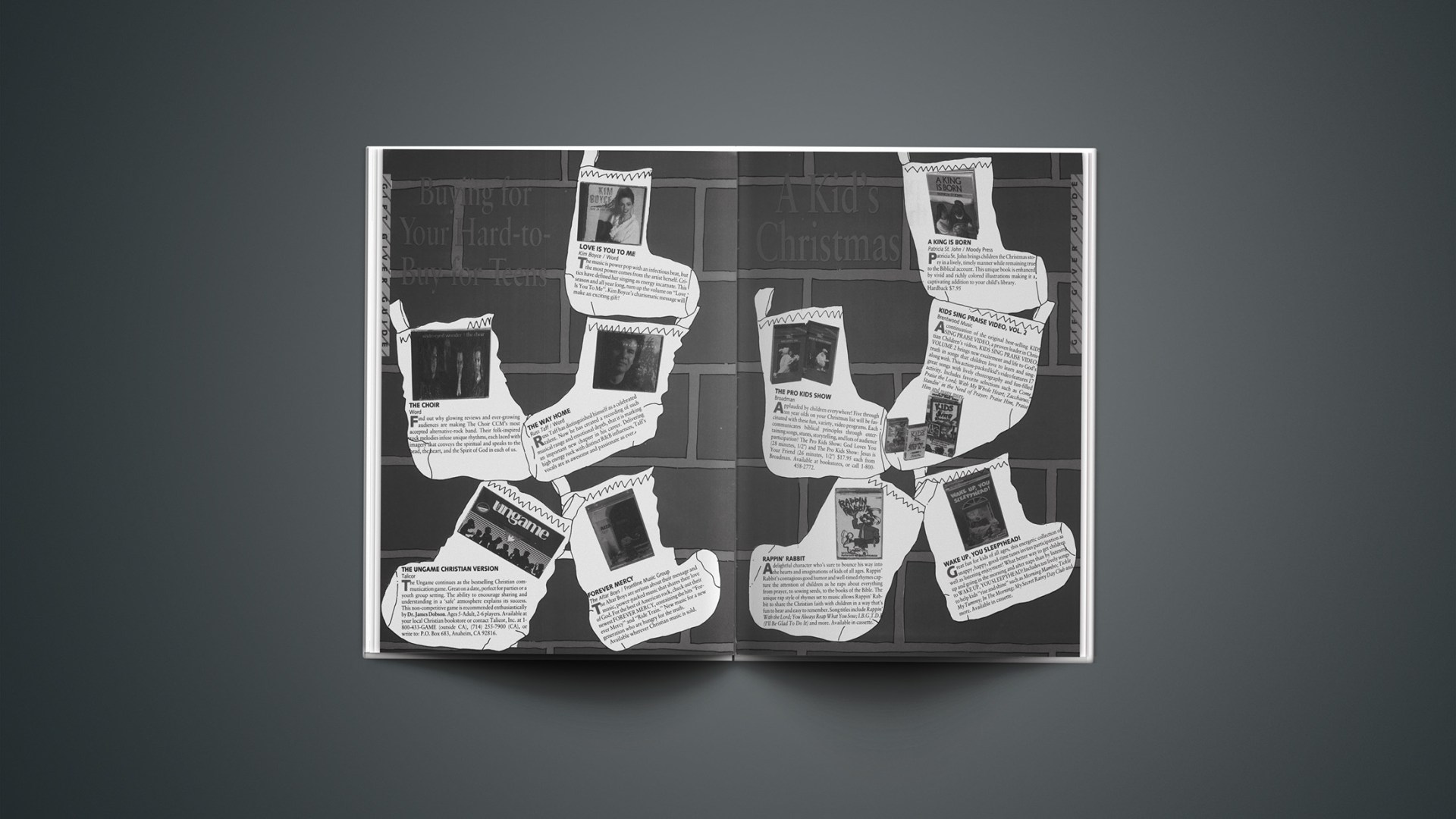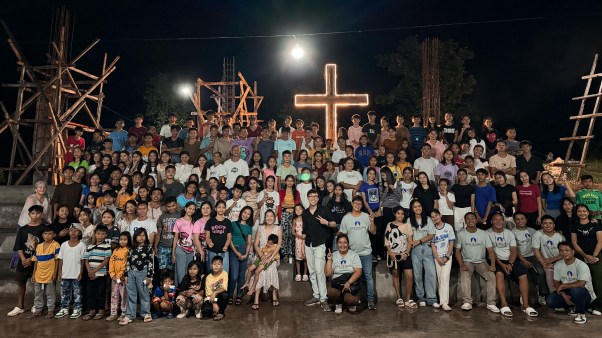Of late parents have not had an easy time finding suitable TV fare for younger children. Saturday morning seems a vast wasteland of stick-figure techno-monsters or cuddly-goo this-or-that. Protest groups complain that most kid-vid pumps sexism and violence and comes wrapped in greedy commercialism that amounts to free-enterprise brainwashing. Nor do prime-time TV or Hollywood flicks do much to improve the options. While the VCR may give parents more control, there has been woefully little “better stuff” to put on it.
Meet A Normal Ten-Year-Old
Few religious groups have done better in coming up with intriguing stuff for kids—until now. The new McGee and Me series, a children’s video adventure series coproduced by James Dobson’s Focus on the Family and Tyndale House Publishers, began appearing last spring. It adopts the same format of dramatic half-hour videos, but there the similarities end. The setting is contemporary and the staging is live action, featuring the personal traumas and moral problems of one Nicholas Martin, a quite normal, but inventive ten-year old. His sidekick/alter ego throughout his travails is McGee, one of Nicholas’s own cartoon drawings come to life. McGee’s existence is known only to Nicholas.
McGee himself is jaunty and rather too fun loving, sometimes prodding Nicholas into foolish actions for which Nicholas must take the rap. Growing up is tough work, and Nicholas learns some hard lessons about peer pressure, unkindness to others, the delusions of pride, and the relish of gore and violence.
Clearly, the series is out to emphasize distinct moral points, which is the mainstay of overtly Christian productions. What sets McGee and Me apart is that in doing so, its touch is at once lighter, livelier, smoother—and more realistic and affecting. The series is by no means perfect, but it far surpasses the moralistic and wooden spiritual bludgeoning often evident in evangelical filmmaking. For one thing, production values sparkle. Film stock, lighting, photography, sound, musical score, and editing compare favorably with good television production: no hanging mikes, shadows, variable colors, or fixed cameras. Especially effective is the difficult and expensive process of superimposing an animated character, McGee, on live-action footage, á la Who Framed Roger Rabbit?
The stories and characters of the first three episodes (of a planned seven) are plausible and generally vivid. Nicholas is a believable, likable kid from a religious family that is devout but not stuffy. Both parents work, and the siblings are obnoxious without being mean. Nice but not goody-goody, Nicholas more or less slides into moral confusion and mistake; his errors cause real pain to himself and others. The endings are neither tidy nor triumphal, as is so often depicted in evangelical drama. Nicholas messes up, and by the end, he largely understands and feels his error.
Perhaps the nicest part of McGee and Me is its tone of glad hopefulness—an atmosphere difficult to translate onto a screen. Ordinary life itself is good, and while it regularly presents problems, being alive can be filled with fineness, supplied as we are with the gifts of friends, family, imagination, play, light, and music.
Using Art To Communicate
The notion that moral and religious teaching deserves art—the best and freshest entertainments believers can come up with, in the manner of C. S. Lewis, Madeleine L’Engle, or Walter Wangerin—has been slow to take root.
Paving the way several years ago was the cartoon studio Hanna-Barbera, maker of Yogi Bear, The Flintstones, and The Jetsons. With no pious purpose in mind, but believing in the inherent appeal of the material, Hanna-Barbera launched The Greatest Adventure: Stories from the Bible, an animated series that faithfully dramatizes different events from Creation to Easter. Here the stories themselves do the work, which is pretty much what the producers intended. Kids enjoy and learn, and adults profit as well. (God is not a bad storyteller in any medium.)
Parents and kids can look forward to the rest of the McGee and Me series. It is a brave venture and off to a good start, though the makers show some reluctance to trust the art to make its point. There is occasional flatness in acting and direction, and over-cuteness in script; two episodes contain more than enough moralizing. Nonetheless, McGee and Me represents a sizable leap in evangelical smarts, care, and creativity. As kids say these days—go for it!
By Roy M. Anker of the Calvin Center for Christian Scholarship at Calvin College, Grand Rapids, Michigan.
Celluloid Evangelism
A martyr, properly defined, is one who chooses to die rather than renounce principles. Romero is a fine film drama based on the controversial life of Oscar Romero, a reticent, bookish churchman, who became a twentieth-century martyr. The heart of this powerful film focuses on Romero’s growth from reluctant clergyman serving in violence-torn El Salvador to consecrated victim.
The story behind the story of the film is also one of principles. Producer Ellwood (Bud) Kieser wore two hats on the set of Romero. As producer he kept his eye on the production, but as pastor and priest, he exhorted his “flock” to give their talents to God as a gift of love. On the Mexican set during filming he conducted a service where crew members placed on the altar symbols of themselves and their crafts. “The director offered the script, the cinematographer his viewfinder, the make-up director her make-up kit. We then asked God to accept these gifts and bless the picture,” he told CT.
“I hope this picture is an act of evangelism,” he said, “because that’s what I tried to make it. It’s the story of what God can do in a person’s life.”
Bud Kieser is far from the stereotypical Hollywood producer. A priest in the Paulist order, which is dedicated to ministering to those outside the Catholic church, Kieser has spent over two decades in Hollywood working in the television industry. Romero is his first foray into the world of theatrical films, and while on the set he became friends with the movie’s star, Raoul Julia.
The Puerto Rican-born Julia, who has become a major box-office draw in films such as Kiss of the Spider Woman and Moon over Parador, became fascinated by the story of Archbishop Romero. He engaged in long, theological discussions with Kieser. (He describes his spiritual journey in the November issue of Sojourners magazine.)
Fellowship Renewed
Born and raised in the Catholic church, Julia fell away from his faith as an adult. As he listened to tapes of Romero’s sermons and diaries to prepare for his role, he began to evaluate his own relationship with God. Kieser introduced him to a Mexican priest who showed him the work of the church in poor villages. Back in New York, Kieser hooked him up with the Campaign for Human Development, a church ministry among the city’s poor.
All this had a profound effect on Julia, who is now back in fellowship with God and the church. Asked by Sojourners, “Are you saying you had a conversion experience?” Julia laughed, “Yes, but don’t use that word or people will say, ‘Oh, Raoul, like Paul, has been knocked from his horse!”
Conversions are not the usual outcome of Hollywood movies, yet Kieser has heard from people who, seeing Romero, have had their own conversion experience. “The picture is about God acting to empower a very frail and human man to love in the midst of hate,” he says. “It’s about God empowering Oscar Romero to live up to his commitment as a Christian in that situation.”
Bud Kieser held four masses on the Mexican set of Romero for a crew of Americans, Australians, and Mexicans. “We were brought together in love by that experience,” he says.
Past interviews have shown me that directors and producers are generally intelligent and thoughtful people. But this was the first time a Hollywood producer signed off by saying, “Pray for us, will you? God bless you.”
By Stephan Ulstein.
A Funhouse-mirror Image
Picture this: a congregation of 12 of the brightest and best of today’s Christian writers. A snow-bound retreat in the Rockies. The agenda: to find one of two things—a supportive community of peers, or the identity of the’ evil, though imaginative, serial murderer(s) stalking the conference.
The choice depends on whether one is talking about the first real conference of the Chrysostom Society (a sort of gender-integrated American Inklings) or the fictional conference of the characters of a tongue-in-cheek mystery, Carnage at Christhaven (Harper & Row).
The characters of the mystery are all caricatures of Chrysostom Society members, and each chapter is written by one of the members. Perhaps to keep himself unspotted from this nether world of death and deception, Philip Yancey declined to write a chapter. So the other members neatly arranged to have Yancey’s alter ego, Nathaniel Yates, iced in the first chapter.
Other well-known names include authors Madeleine L’Engle (the tall, elusive Phillipa D’Esprit), Richard Foster (the holier-than-anyone George Gloster), Karen Burton Mains (the “cuddly” Shirley Kerns), and Calvin Miller (the hug-hungry Wesley Wilier).
Edited by Bill Griffin (S. J. Smith), the collection is funnier if you know the real writers’ works and quirks. But knowing them is not a prerequisite to enjoying the unfolding and refolding mystery. The writers themselves (except the last one) had no idea whodunit.
In the end, poor Harold Fickett (the sour-mouthed Harold Hastings) had the unwieldly job of piecing together the scraps of clues the other writers had dropped. Not only does Fickett reveal the real murderer(s), but he comes to an honest conclusion about the state of the Christian writing business today.
The writers do a fine parody of their individual and collective faults. Wilier is described by Dolph Adolffson (Walter Wangerin) as too happy, “smiling as though all the world were a potluck supper.” Yet Adolffson describes himself as a “brooding Lutheran.”
To rid the surviving characters of tragic flaws, Fickett includes a literary exorcism. Sprites and weird beings with names such as Paranoid Prophet, Treacly Verse, and even Genre Fiction escape from the circle of sickened characters. To his credit, Fickett’s character announces his own evil spirit of Criticism as it blows out from his mouth “in a cloud of octopussical ink.”
If this sounds like abnormal fare for these upstanding writers, you’re right. It is as if the real writers stepped off the second-story balcony of the retreat house, wanting to “experience firsthand the problem of pain.” That, after all, was what poetic publisher Agatha Gaines (Luci Shaw) suggested as the reason for Yates’s untimely demise.
But this departure is not meant as literary suicide. The writers wanted to stretch beyond the stiff boundaries of Christian publishing houses. By writing an exaggerated group-autobiography, they hope to be seen in a truer light.
By Margaret D. Smith.










